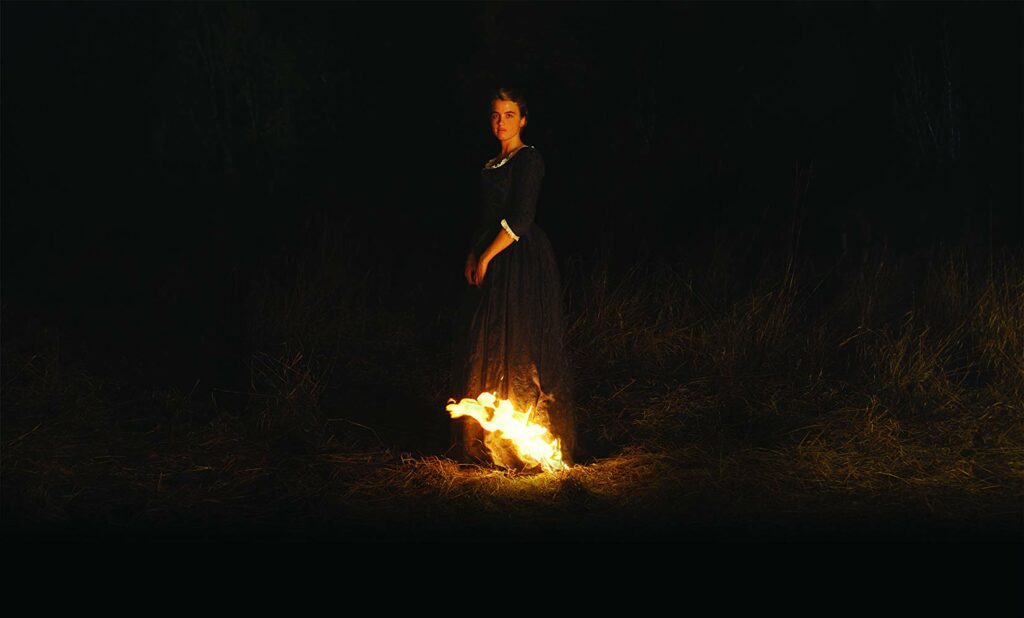Portrait of a Lady on Fire is an ode to the process of feminine creation; it is a story about making love and art, about the intimacy of the gaze and the immortality of memory, about building a space that, even just for a moment, is boundless and free. It is director Céline Sciamma’s love letter to both one woman and all women.

PThe French director, known for her contemporary explorations of gender and sexuality, here ventures into 1770s Brittany. Its imposing, isolated landscapes serve as the backdrop to a haunting romance; evoking the Romantic sublime, the scenery telegraphs that here is a place where social conventions can, however briefly, be suspended. So enters Marianne (Noémie Merlant), who has been commissioned by a Countess (Valeria Golino) to paint her daughter Héloïse’s (Adèle Haenel) wedding portrait. Upon meeting her, the mother warns that another artist has already attempted and failed at the task because Héloïse, in protest of her marriage, refuses to sit for the portrait. To avoid the same thing from happening, Marianne is introduced to her as a walking companion in order to observe her subject and paint her in secret. It’s in these stolen moments that the women begin to fall piece by piece in love with one another, even as the awareness of their relationship’s impossibility and inevitable end weighs on them.

The poignant tale is made still more bittersweet by the film’s origin. Sciamma has said she conceived the screenplay for Haenel, a woman she fell in love with during their collaboration on her first feature, Water Lilies (2007). Though their relationship would come to a close after many years, their desire to collaborate has obviously remained undamaged by their separation. With this artistic context in mind, it’s easy to recognise the echoes between Portrait’s narrative and that of its own creation, making it ever more affecting.
The film’s ending is disclosed from the very opening: this is a love affair which could only exist in a fleeting and fragile moment, one never intended to last. In doing this, Sciamma shows respect for the reality of these women’s lives in the 18th century. Héloïse and Marianne do not have an exceptional destiny, nor is their story aimed to satisfy an audience’s modern susceptibilities; to do so would be an erasure of historic realities. Yet with what time they have together, the protagonists are able to create a utopic haven from which men are – at least physically – banished, and hence conventional dynamics of power become irrelevant. This allows for an inventive portrayal of love where overused sources of tension and negotiation, like that of gender domination, leave space for the exploration of new discourses.

One of these discourses is that surrounding the gaze. With only women in front of and behind the camera, the male gaze is supplanted. Where the latter concerns itself with the objectification and consumption of the female body, the female gaze reclaims and appreciates the body as an active site of love and art. Merlant, with her strangely large, all-consuming irises, personifies the female gaze as the artist hungrily studying her model. It’s through her gaze that Héloïse’s truest self is eventually revealed. The camera often rests, contemplative, on close-ups of their faces, allowing for a study of the life in their faces rather than the sexuality of their bodies.
In this way, the audience is invited not only to participate in the female gaze, but in the creative process. “Do all lovers feel like they’re inventing something?” asks Héloïse, her words continuing to weave the act of looking and love in with the act of creation. Between her and Marianne, the portrait on which they collaborate becomes a third presence, simultaneously the product of their love and the object that will tear them apart; life and loss, celebration and mourning infuse consequence into every shot of Marianne’s brushstroke. With this relationship, Sciamma also subverts the myth of the muse. No longer is the model viewed as the silent, fetishised inspiration for male artistry; rather the muse is, and always has been, an active collaborator in the making of great art.

Portrait delicately layers its story. It’s a quietly revolutionary deconstruction of the male gaze, bringing forth a new lens through which to view women’s agency and historic contributions to art and culture, wrapped inside a gentle yet painful love story. It is intellectually stimulating without being alienating, breathtakingly beautiful without sacrificing narrative depth, meditative without losing its devastating emotional power. Portrait of a Lady on Fire is, in every conceivable way, an incandescent masterpiece.
Portrait of a Lady on Fire releases February 28th.
